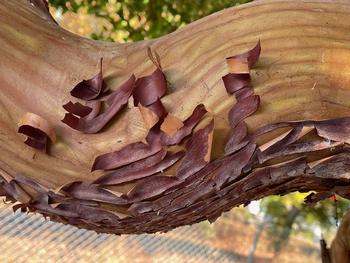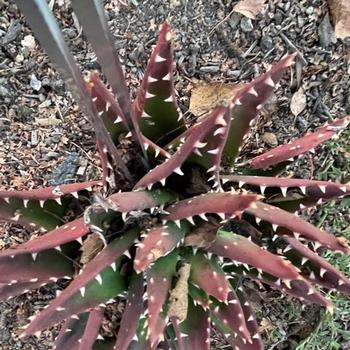The Latest Dirt - Nov 2023
Living in Wildfire Country: Unexpected Dangers in the Firewise Garden
Article and photos by Marilyn Saarni, Resilient Regenerative Firescaping Certified (Rescape, 2020)

Plants with thorns. Honestly, don’t plant these anywhere you have to clear leaves and weed year-round. That is, nowhere in your Zone 0 (“Ignition Zone”) or 1 (“Lean and Green Zone”). And if you have a pine or fir tree—or your neighbors do—consider avoiding planting them anywhere in your entire defensible zone. Or, as I have strategized with my big climber roses, prune all the foliage in the lower four feet of branching, open up the framing, and have no groundcovers underneath. This way, you can rake around the thorny plants—the debris will blow through or fall on the ground. An additional strategy could be to mulch with cobble under stickery plants (if weeds are an issue, lay cardboard underneath the cobble—but keep 3-4 inches clear around the trunk of the plants).
You can then use an electric variable blower to help control flammable debris under these plants without risking an eye, getting stuck, or tearing another hole in your jacket or vest. As someone who maintains a 35-foot-long succulent bed, I also recommend no cactuses, thorny agaves, or aloes. Or if you want to keep them, consider putting them in large pots. The raised height reduces the amount of leaf debris that will collect in them (except pine and fir needles). The height also makes it easy to access. You’ll need long tweezers to maintain these plants. Another approach might be to plant them outside your defensible zone. Remember not to place these plants where they can endanger passersby (near sidewalks or paths) or get in the way of firefighters (by evacuation routes, driveways, or where they may need access to save structures).

Another culprit is the Mahonia genus. Wow, their thorny leaf tips are definitely the last to rot. I have long removed all the Mahonias—two deep punctures were enough for me. Some leaves don’t hurt your hands until they dry up. Two are the Arbutus unedo (Strawberry Tree) and Olea europaea (Olive). These leaves aren’t prickly while fresh and green, but as they dry, the Strawberry Tree leaves get sharp edges, and the Olive leaves curl lengthwise and develop a sharp tip. They are both fairly heavy litterers, and their leaves don’t tend to blow so far (unlike Pines, Firs or Oaks), so likely you’ll not run into these unless they’re in your garden or very close by.
An additional issue with the Strawberry Tree is that if you have a heavy bark-peeling variety, you’ll have to use your heaviest leather gloves to break off the loose strands that could catch embers—the bark peels can be as sharp as razors. Besides avoiding these trees in the garden, you could also clear a more expansive zone around them and surround them with large cobbles so that you can use a blower. Avoid planting areas nearby that require hand-picking of leaf debris (a succulent bed, for example).

Protection. I always wear gloves now when clearing debris in the garden. For fine work (my succulent bed), I also wear my reading glasses to see the oak leaves before they bite me. And for my few gorgeous but toothy aloes, I use tweezers that are 12 inches long. For garden beds lined with rock mulch, I can use a blower to pile the leaves in a corner and then quickly pick them up with my heavier neoprene gloves, reducing skin contact to a minimum. I wear glasses whenever I use the blower; dust does kick up if I accidentally hit a small pocket of compost near the pebbles. Last, I carry a bucket everywhere I wander, so I never handle prickly leaves twice.
If you have any plants that have injured you, especially when you didn’t expect it, or tree leaves that have surprised you by cutting or puncturing you, please list the species or name in an email and send it to mesaarni@gmail.com. If you have come up with other ways to cope with prickles in the firewise garden, I’d love to hear about them. Send photos!
